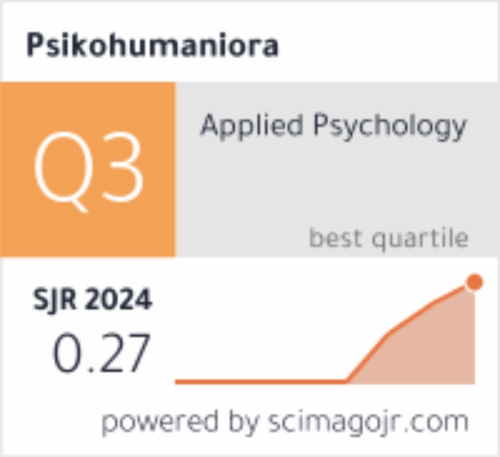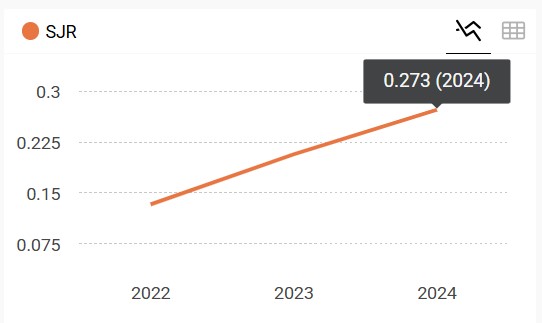Changing maladaptive beliefs among individuals with coronary heart disease using video information
DOI:
https://doi.org/10.21580/pjpp.v6i2.9406Keywords:
anxiety, CHD, depression, maladaptive beliefs, video informationAbstract
Many individuals with coronary heart disease (CHD) have erroneous beliefs about the condition, which in turn increases anxiety and depression. Providing information and facts about CHD through video may be able to correct the wrong conceptions of individuals about their disease. A total of 150 individuals with CHD at Hasan Sadikin Hospital, Bandung, Indonesia (male = 65%, female = 35%) were divided into a control group and two experimental groups, with a quasi-experimental before-after design. The participants completed the York Cardiac Beliefs questionnaire at the start of the measurement, immediately after watching the video (time 1), and again after watching the video six times over a two week period (time 2). Beck Anxiety Inventory and Beck Depression Inventory-II questionnaires were also completed by participants at the beginning of the experiment and at time 2. The repeated measures ANOVA analysis showed a significant decrease in both experimental groups in terms of wrong beliefs about CHD (t=8.68 & 8.69, p< .01), anxiety (p< .01), and depression (t=8.17 & 7.76, p< .01). Watching videos giving facts and information about CHD can therefore correct erroneous beliefs about CHD, and reduce levels of anxiety and depression in individuals suffering from the disease.
Downloads
References
Adwas, A. A., Jbireal, J. M., & Azab, A. E. (2019). Anxiety: Insights into signs, symptoms, etiology, pathophysiology, and treatment. East African Scholars Journal of Medical Sciences, 2(10), 80–91.
Backhoff, E., Larrazolo, N., & Rosas, M. (2000). The level of difficulty and discrimination power of the basic knowledge and skills examination (EXHCOBA). Revista Electrónica de Investigación Educativa, 2(1), 1–16.
Bandura, A. (1993). Perceived self-efficacy in cognitive development and functioning. Educational Psychologist, 28(2), 117–148. https://doi.org/10.1207/s15326985ep2802_3
Bartholomew, L. K., Parcel, G. S., Kok, G., Gottlieb, N. H., & Fernandés, M. E. (2011). Planning health promotion program: An intervention mapping approach (3rd ed.). Jossey-Bass.
Beck, A., T., & Steer, R., A. (1993). Beck anxiety inventory manual. Harcourt Brace and Company.
Beck, A. T., Steer, R. A., & Brown, G. K. (1996). BDI-II, Beck Depression Inventory: Manual (2nd ed.). Harcour, Brace, & Company.
Blickem, C., Bower, P., Protheroe, J., Kennedy, A., Vassilev, I., Sanders, C., Kirk, S., Chew-Graham, C., & Rogers, A. (2011). The role of information in supporting self-care in vascular conditions: A conceptual and empirical review. Health & Social Care in the Community, 19(5), 449–459. https://doi.org/10.1111/j.1365-2524.2010.00975.x
Bunker, S. J., Colquhoun, D. M., Esler, M. D., Hickie, I. B., Hunt, D., Jelinek, V. M., Oldenburg, B. F., Peach, H. G., Ruth, D., Tennant, C. C., & Tonkin, A. M. (2003). “Stress” and coronary heart disease: Psychosocial risk factors. Medical Journal of Australia, 178(6), 272–276. https://doi.org/10.5694/j.1326-5377.2003.tb05193.x
Chee, G., Borowitz, M., & Barraclough, A. (2009). Private sector health in Indonesia. USAID - Health Systems 20/20 project, Abt Associates Inc.
Dirjen Kesehatan Masyarakat. (2010). Pedoman pelaksanaan jaminan pemeliharaan kesehatan. Kemenkes RI.
Dit. Pelayanan Kafarmasian. (2013, February 28). Pharmaceutical care untuk pasien penyakit jantung koroner: Fokus sindrom koroner akut (2006). falmakes.kemenkes.go.id; Direktorat Bina Kefarmasian dan Alat Kesehatan, Depkes. https://farmalkes.kemkes.go.id/2013/02/pharmaceutical-care-untuk-pasien-penyakit-jantung-koroner-fokus-syndrom-koroner-akut/
Ferriter, M., & Huband, N. (2005). Does the non-randomized controlled study have a place in the systematic review? A pilot study. Criminal Behaviour and Mental Health, 15(2), 111–120. https://doi.org/10.1002/cbm.43
Foxwell, R., Morley, C., & Frizelle, D. (2013). Illness perceptions, mood and quality of life: A systematic review of coronary heart disease patients. Journal of Psychosomatic Research, 75(3), 211–222. https://doi.org/10.1016/j.jpsychores.2013.05.003
Furze, G. (2007). Cardiac misconceptions - A problem in need of treatment? Practical Cardiovascular Risk Management, 5(1), 13–15.
Furze, G., Dumville, J. C., Miles, J. N. V., Irvine, K., Thompson, D. R., & Lewin, R. J. P. (2009). “Prehabilitation” prior to CABG surgery improves physical functioning and depression. International Journal of Cardiology, 132(1), 51–58. https://doi.org/10.1016/j.ijcard.2008.06.001
Furze, G., Lewin, R. J. P., Murberg, T., Bull, P., & Thompson, D. R. (2005). Does it matter what patients think? The relationship between changes in patients’ beliefs about angina and their psychological and functional status. Journal of Psychosomatic Research, 59(5), 323–329. https://doi.org/10.1016/j.jpsychores.2005.06.071
Ghisi, G. L. de M., Abdallah, F., Grace, S. L., Thomas, S., & Oh, P. (2014). A systematic review of patient education in cardiac patients: Do they increase knowledge and promote health behavior change? Patient Education and Counseling, 95(2), 160–174. https://doi.org/10.1016/j.pec.2014.01.012
Ginting, H., Näring, G., & Becker, E. S. (2013). Attentional bias and anxiety in individuals with coronary heart disease. Psychology & Health, 28(11), 1306–1322. https://doi.org/10.1080/08870446.2013.803554
Ginting, H., Näring, G., van der Veld, W. M., Srisayekti, W., & Becker, E. S. (2013). Validating the Beck Depression Inventory-II in Indonesia’s general population and coronary heart disease patients. International Journal of Clinical and Health Psychology, 13(3), 235–242. https://doi.org/10.1016/S1697-2600(13)70028-0
Goulding, L., Furze, G., & Birks, Y. (2010). Randomized controlled trials of interventions to change maladaptive illness beliefs in people with coronary heart disease: Systematic review. Journal of Advanced Nursing, 66(5), 946–961. https://doi.org/10.1111/j.1365-2648.2010.05306.x
Gysels, M., & Higginson, I. J. (2007). Interactive technologies and videotapes for patient education in cancer care: Systematic review and meta-analysis of randomised trials. Supportive Care in Cancer, 15(1), 7–20. https://doi.org/10.1007/s00520-006-0112-z
Inaheart. (2021). Find doctor: Find cardiologist in your area. Indonesian Heart Association. https://membersearch.inaheart.org/#/
Jamshidi, N., Abbaszadeh, A., & Kalyani, M. N. (2011). Effects of video information on anxiety, stress and depression of patients undergoing coronary angiography. Pakistan Journal of Medical Sciences, 25(2), 901–905.
Kementerian Kesehatan Republik Indonesia. (2018). Laporan nasional riset kesehatan dasar 2018. Lembaga Penerbit Balitbangkes.
Koerner, N., Tallon, K., & Kusec, A. (2015). Maladaptive core beliefs and their relation to generalized anxiety disorder. Cognitive Behaviour Therapy, 44(6), 441–455. https://doi.org/10.1080/16506073.2015.1042989
Kubzansky, L. D., Cole, S. R., Kawachi, I., Vokonas, P., & Sparrow, D. (2006). Shared and unique contributions of anger, anxiety, and depression to coronary heart disease: A prospective study in the normative aging study. Annals of Behavioral Medicine, 31(1), 21–29. https://doi.org/10.1207/s15324796abm3101_5
Latif, S., Ahmed, I., Amin, M. S., Syed, I., & Ahmed, N. (2016). Exploring the potential impact of health promotion videos as a low cost intervention to reduce health inequalities: A pilot before and after study on Bangladeshis in inner-city London. London Journal of Primary Care, 8(4), 66–71. https://doi.org/10.1080/17571472.2016.1208382
Leventhal, H., Benyamini, Y., Brownlee, S., Diefenbach, M., Leventhal, E. A., Patrick-Miller, L., & Robitaille, C. (1997). Illness representations: Theoretical foundations. In K. J. Petrie & J. A. Weinman (Eds.), Perceptions of health and illness: Current research and applications (pp. 19–47). Harwood Academic Publishers.
Ludwick-Rosenthal, R., & Neufeld, R. W. (1988). Stress management during noxious medical procedures: An evaluative review of outcome studies. Psychological Bulletin, 104(3), 326–342. https://doi.org/10.1037/0033-2909.104.3.326
Mahler, H. I. M., & Kulik, J. A. (1998). Effects of preparatory videotapes on self-efficacy beliefs and recovery from coronary bypass surgery. Annals of Behavioral Medicine, 20(1), 39–46. https://doi.org/10.1007/BF02893808
Mahler, H. I. M., & Kulik, J. A. (2002). Effects of a videotape information intervention for spouses on spouse distress and patient recovery from surgery. Health Psychology: Official Journal of the Division of Health Psychology, American Psychological Association, 21(5), 427–437.
Mahler, H. I. M., Kulik, J. A., & Hill, M. R. (1993). A preliminary report on the effects of videotape preparations for coronary artery bypass surgery on anxiety and self-efficacy: A simulation and validation with college students. Basic and Applied Social Psychology, 14(4), 437–453. https://doi.org/10.1207/s15324834basp1404_4
Morrison, V., & Bennett, P. (2006). An introduction to health psychology. Pearson Education.
Orringer, J. S., Fendrick, A. M., Trask, P. C., Bichakjian, C. K., Schwartz, J. L., Wang, T. S., Karimipour, D. J., & Johnson, T. M. (2005). The effects of a professionally produced videotape on education and anxiety/distress levels for patients with newly diagnosed melanoma: A randomized, prospective clinical trial. Journal of the American Academy of Dermatology, 53(2), 224–229. https://doi.org/10.1016/j.jaad.2005.03.061
Rankin, S. H., Stallings, K. D., & London, F. (2005). Patient education in health and illness. Lippincott Williams & Wilkins.
Sirois, B. C., & Burg, M. M. (2003). Negative emotion and coronary heart disease. Behavior Modification, 27(1), 83–102. https://doi.org/10.1177/0145445502238695
Sørlie, T., Busund, R., Sexton, J., Sexton, H., & Sørlie, D. (2007). Video information combined with individualized information sessions: Effects upon emotional well-being following coronary artery bypass surgery—A randomized trial. Patient Education and Counseling, 65(2), 180–188. https://doi.org/10.1016/j.pec.2006.07.006
Stanley, K. (2007). Design of randomized controlled trials. Circulation, 115(9), 1164–1169. https://doi.org/10.1161/circulationaha.105.594945
Taylor, E. S. (2006). Health psychology (6th ed.). McGraw-Hill.
Downloads
Published
How to Cite
Issue
Section
License
The copyright of the accepted article shall be assigned to the publisher of the journal. The intended copyright includes the right to publish the article in various forms (including reprints). The journal maintains the publishing rights to published articles.
In line with the license, authors and any users (readers and other researchers) are allowed to share and adapt the material only for non-commercial purposes. In addition, the material must be given appropriate credit, provided with a link to the license, and indicated if changes were made. If authors remix, transform, or build upon the material, authors must distribute their contributions under the same license as the original.



